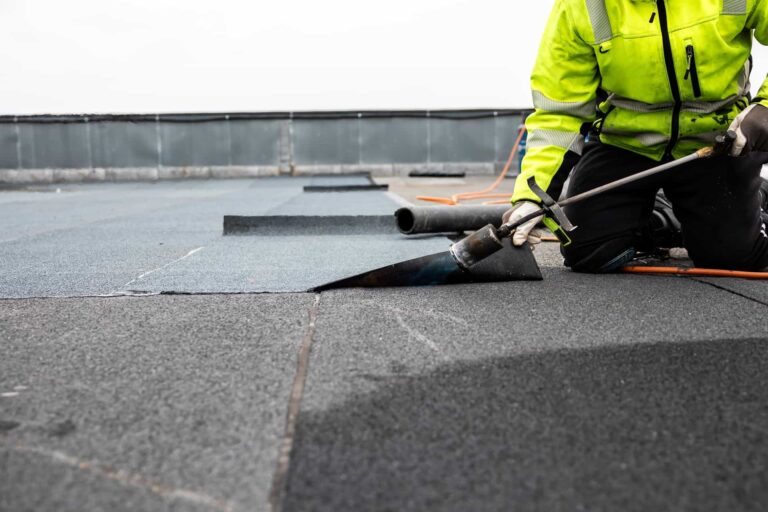If you’re looking for a cost-effective roofing solution for sheds, garages, or flat-roof buildings, roll roofing may be just what you need. Especially practical for flat roof projects, asphalt roll roofing offers a fast, lightweight alternative to traditional shingles. In this guide, we’ll cover:
-
What roll roofing is and how it differs from shingles
-
Why it’s ideal for flat-roof applications
-
Key strengths and limitations of asphalt roll roofing
-
Useful installation advice, real-world examples, and when to get a professional inspection
What Exactly Is Roll Roofing?
Roll roofing comes in long strips—typically 3 feet wide and up to 100 feet long—made from asphalt-saturated felt with a granule coating. Lightweight and flexible, asphalt roll roofing serves as a budget-friendly substitute for conventional shingles. It is most commonly used on flat roof surfaces or very low-pitched roofs due to its ease of installation and minimal seam coverage.
Installation involves rolling it out across the surface, securing it with nails or adhesive, and sealing overlapping seams. Proper drainage and seam sealing are essential to ensure water doesn’t infiltrate.
Common Types of Roll Roofing:
-
Asphalt Roll Roofing – The most common, affordable, and flexible option
-
Mineral-Surfaced Roll Roofing – Adds granule protection for increased durability
-
Saturated Felt Roll Roofing – Used as temporary coverage or underlayment
-
Rubber Roll Roofing – Recycled rubber material, ideal for flat roofs
Benefits of Roll Roofing
1. Extremely Budget-Friendly
Roll roofing is among the most affordable roofing materials available. It’s cost-effective in terms of both materials and labor, especially if you opt for a DIY installation.
2. Simple and Fast to Install
With minimal tool requirements—just a roll-out, fasteners, and seam sealing—it’s easy to install on flat roof surfaces and small structures.
3. Lightweight and Easy on Structure
This roofing type is light enough for older buildings or sheds that may not support heavier materials like shingles or metal.
4. Designed for Flat or Low-Slope Roofs
Roll roofing for flat roof is ideal for waterproof coverage, with fewer potential leak points thanks to its overlapping sheet design.
5. Great For Temporary or Secondary Use
Perfect as a short-term roofing solution or for non-residential applications like storage sheds and workshops.
Downsides of Roll Roofing
1. Limited Lifespan
Expect it to last only about 5–8 years, significantly shorter than other roofing options such as asphalt shingles (15–25 years) or metal systems.
2. Less Durable
The thin material is prone to punctures, wind damage, UV degradation, and hail impact.
3. Lacks Visual Appeal
Roll roofing offers very limited aesthetics—making it less suitable for homes or structures where curb appeal matters.
4. Not Suitable for Sloped Roofs
It works only on flat or low-pitched roofs. In steeper installations, drainage and seam integrity become problematic.
5. Increased Risk of Leaks
Badly sealed seams, fastener holes, or standing water can compromise the integrity of the roofing system.
Is Roll Roofing Right for Your Project?
Ideal Use Cases:
-
Flat-roof outbuildings like sheds, garages, or tool structures
-
DIY applications with modest budgets
-
Temporary roofing until a more permanent option can be installed
When to Consider Other Options:
-
If long-lasting durability or aesthetics are priorities
-
In severe weather zones with strong storms or intense sun
-
On your main living space where quality matters most
Frequently Asked Questions (FAQ)
Q: How does asphalt roll roofing differ from asphalt shingles?
A: Roll roofing is less expensive and faster to install, but it doesn’t last as long and lacks the visual finesse of shingles.
Q: Can I install roll roofing myself?
A: Yes—you can with basic tools and skills. Be sure to ensure proper drainage and seam sealing.
Q: How long will it last?
A: Typically 5–8 years, depending on the weather exposure.
Q: Is roll roofing waterproof for flat roofs?
A: If installed and sealed well, it can be. Still, it offers less waterproof reliability compared to rubber or TPO roofing membranes.
Installation Tips for Better Performance
-
Confirm your roof is flat or very low slope.
-
Plan for proper drainage to avoid standing water.
-
Overlap sheets by 2+ inches and seal seams with roofing cement or seam tape.
-
Minimize foot traffic on the roof to avoid punctures.
-
Inspect yearly and plan roof replacement within 5–8 years.
Other Roofing Options Worth Considering
-
Architectural Shingles – Long lifespan (15–30 years) with better style
-
Rubber Roofing (TPO/EPDM) – Excellent flat-roof performance and durability
-
Metal Roofing – Energy-efficient, durable, but with higher upfront costs
Final Verdict
Roll roofing, particularly asphalt roll roofing, is a practical, budget-conscious option for small, flat-roofed structures. It’s easy to install, lightweight, and affordable—but doesn’t offer long-term durability or aesthetic value. For primary living spaces or areas needing longevity and style, it’s better to explore shingles, metal, or rubber roofing options.
Still Unsure? Contact ProTec Inspections Today
Not sure if roll roofing is right for your flat roof project? Considering a more durable roof but unsure which type to choose? ProTec Inspections offers expert roof assessments tailored to your needs. They’ll evaluate your structure, climate exposure, and usage to recommend the smartest roofing option—whether it’s affordable roll roofing or a more permanent solution.
📞 Contact ProTec Inspections now for a free consultation and make sure you invest in the right roofing system for your property and budget.
